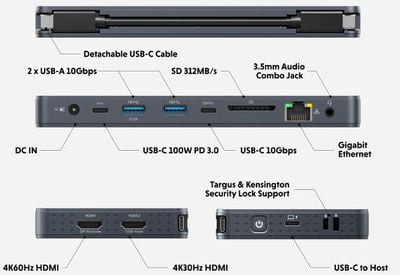Popular accessory brand Hyper has announced the launch of its new "HyperDrive Next" product lineup with a variety of connectivity solutions that embrace the latest standards while focusing on the use of recycled materials.
The largest portion of the lineup is a series of USB-C hubs that include USB 3.2 support, SD 4.0 card slots with up to 312 Mbps transfer speeds, and Power Delivery 3.1 support with up to 140 watts of passthrough power available on select models.
 Dual 4K HDMI 7 Port USB-C Hub
Dual 4K HDMI 7 Port USB-C HubThe hub likely of most interest to Mac users is the HyperDrive Next Dual 4K HDMI 7 Port USB-C Hub, which unsurprisingly includes dual 4K monitor support for M1 and M2 families of MacBooks via HDMI (one at 60Hz and one at 30Hz), as well as a pair of 10 Gbps USB ports, a 10 Gbps USB-A port, a 3.5mm combo audio jack, and 100 watts of passthrough power. It's priced at $149.99.
 USB4 NVMe SSD Enclosure
USB4 NVMe SSD EnclosureAnother member of the HyperDrive Next family is the new USB4 NVMe SSD Enclosure, which offers support for M.2 NVMe SSDs up to 16TB with transfer speeds up to 40 Gbps. Built with 100% recycled aluminum, the enclosure carries an IP55 rating for water and dust resistance and is priced at $119.99. You'll of course need to supply your own SSD for the enclosure, but with a snap-in design, no tools are required.
 10 Port Business Class USB-C Dock
10 Port Business Class USB-C DockFinally, users with more demanding needs may be interested in the HyperDrive Next 10 Port Business Class USB-C Dock. It includes support for dual 4K displays across PCs, Macs, and Chromebooks with two HDMI ports (1 60Hz, 1 30Hz), plus 10 Gbps USB ports (two USB-C and one USB-A), and an additional 100-watt USB-C charging port. There are also a Gigabit Ethernet port, a 3.5mm combo audio jack, an SD 4.0 card slot, a detachable USB-C cable that snaps into the side of the dock for travel, and slots for both Targus and Kensington locks, all in a slim design for $199.99.
Note: MacRumors is an affiliate partner with Hyper. When you click a link and make a purchase, we may receive a small payment, which helps us keep the site running.























Top Rated Comments
My last Hyper AC adapter made a full three days before arcing, sparking, and blowing up in the wall. Good thing I was home, although it’d have likely snuffed itself out because, you know, electrical code and proper design and not keeping combustibles near outlets/heat sources, so I don’t mean to be dramatic about this (and anything with excited electrons has some risk and things do fail), but they have a star studded history of really poor build quality where it really matters (e.g. not just poor fit and finish, but really poor isolation where it matters for safety).
Will never buy another Hyper. Ever. I don’t care who has bought them and what they claim to have changed. Not because companies and products can’t recover from stuff like this, but their utter lack of transparency and taking this seriously is deeply troubling.
Looks like a good dock here though!
This is across product lines. Batteries, hubs and chargers.